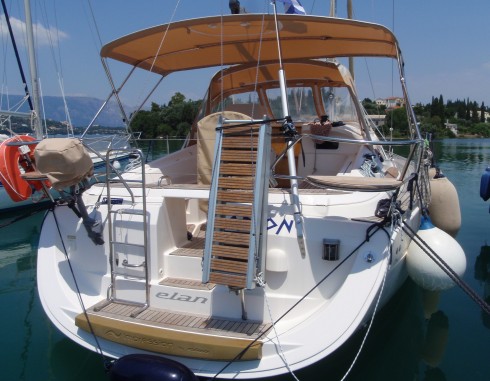EUROBOAT
There is a commonality of features on most of the boats we have seen in the Mediterranean. These are features that seem to make boats particularly suited for the berthing and anchoring conditions throughout the Med – specifically ‘Med mooring’ where you either drop your anchor or pick up a ‘tailed line’ some distance out then back in to a space (often narrower than the beam of your boat). We have started referring to boats with these features as “Euroboats”.
Passage is definitely not a Euroboat. She has countless wonderful features, and we would not trade her for any Euroboat afloat, but she is abysmal at Med mooring (as are we). Here is a list of features on many Euroboats and Passage’s lack thereof…
– Many (most?) Euroboats have bow thrusters. Passage does not. (we have seen them on boats as small as 30’)
– Many Euroboats can control their anchor windlass from the helm. Passage requires someone on the foredeck.
– Very few Euroboats have a staysail so they can stow their dinghy on the foredeck. Passage has a staysail, and her dinghy is stowed on davits off the stern.
– Most Euroboats have an aft cockpit. Passage has a center cockpit.
– Most Euroboats have line chocks and cleats at waist height. There is nothing cluttering their stern as lines lead to lay-in chocks then cleats. That enables handling stern lines without leaving the helm. Passage has lots of stuff on her stern creating a cluttered lead to actual hawse holes at deck level that require one to run lines through them, and those are 15’ behind the helm.
– Most Euroboats have a walk-through transom enabling easy access to the dock. Passage has a stainless rail around the transom that must be crawled over.

The perfect Euroboat – note the built in rubber bumper
These features make the Euroboat easy to Med moor, but the Euroboat also has other convenience features seemingly designed around this method of mooring. Many Euroboats have a panel of connectors on their transom. They have centralized their inlets (fuel, water, electricity) and outlet (waste) in a panel that somewhat resembles an RV. This provides easy access when the boat is backed in. Most have integrated pasarelles (gang planks), and some even have built in fenders to prevent damage if/when they back in to the dock.
Meanwhile, Passage remains hopelessly poor at backing up. Yes, we have a skeg-hung rudder and a Max Prop, but we cannot blame it all on the boat. We have just not gotten the hang of it. But no matter how many times we try, Passage will never back up like a Euroboat. She is just not designed for it – nor are we.
Return to our page on sailing in Europe.